Optimizing your Google Ads to get the most out of your budget involves lots of things: ad copy, targeting, scheduling, and more. But what a lot of advertisers don’t realize is that their ability to do all of that—and to do it efficiently—is impacted by how their account is structured in the first place.
And with all its layers, features, and settings, mastering (let alone understanding) Google Ads account structure isn’t easy.
Until now.
Enter the A-to-Z visual guide to Google Ads account structure. In it, I’m going to break down a Google Ads account into its key components and demystify the features and settings available at each level. Plus, I’ll provide tips so that you can efficiently manage your campaigns and budget, keep your ads relevant and Quality Score high, and, most importantly, keep your costs low
It’s like the easy button for Google Ads account management! Let’s hit it.
Contents
- Why is your Google Ads account structure so important?
- Full account overview
- Account
- Campaigns
- Ad groups
- Keywords
- Ads
Why is your Google Ads account structure so important?
Let’s take a step back–what is even meant by account structure, and why is it so important?
I’m glad you asked. Put simply, the way you structure your Google Ads account allows you to control how you want your ads to be triggered and when and where you want them to appear. Not having a well-structured account is like attempting to drive a car that’s not properly built–accidents are bound to happen.
Keep in mind that having a well-structured account will:
- Ensure that the searches triggering your ads are relevant to your audience.
- Result in better Quality Scores, which, in turn, brings better results and lower prices. Quality score is essentially the scale of how much Google likes you (and trust me, you want Google to love you!).
- Keep you organized and able to optimize. If your account is a mess, then you’re likely to get lost in the mess, your results will plummet (or never arrive), and optimizing to get better results will be out of the question. So keep in mind organization (and your own sanity) when structuring your account.
⛳️ Want to take this tutorial to go? Download our free guide on How to Build the Perfect Google Ads Account Structure
Google Ads account overview
A Google Ads account is more than just one account with a bunch of ads. So let’s start with a big-picture overview of its key components:
- Account: This is the outer shell, with your business and payment information that houses everything.
- Campaigns: Campaigns house your ad groups. You can only have one ad type (Search vs. Display, for example) per campaign, but you can (and should) have multiple ad groups within a campaign, and you can (and should) have multiple campaigns per account.
- Ad groups: These contain your ads and keywords and are grouped by theme.
- Keywords: These are the terms that you want to trigger your ads to show in the search engine results page (SERP).
- Ads: This is the actual copy and creative that appears on the SERP.
- Landing page: The page viewers land on once they click your ad. You will have only one landing page per ad group. Given landing page best practices—namely, how specific it should be to the offering and the ad promoting it—you can get a feel for how ad groups are organized.
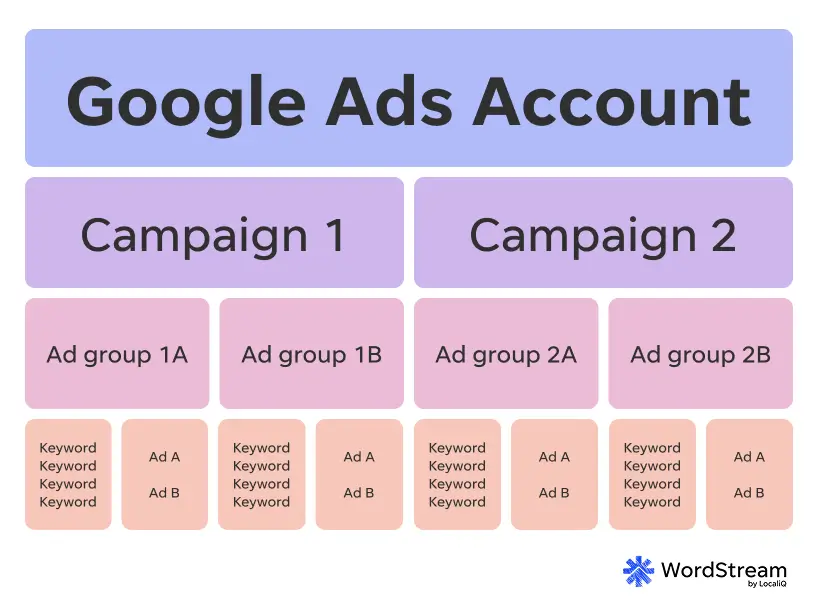
There are different groupings and levels, and certain features and settings are only available at certain levels within your account.
At first, this may feel confusing, but in the end, it’s designed this way to help you streamline things as much as possible and customize where necessary.
So let’s dive into each layer within your account so you can see what I mean.
The account level
The shell of your Google Ads account is the first layer of PPC management that is often referred to as the “account level.” This is where big-picture portions of your Google Ads get taken care of, like your billing, user permissions, and more.
How do I create a Google Ads account?
To create a Google Ads account, go to ads.google.com and have an email address handy. It doesn’t necessarily have to be a Gmail account.
What is a Google Ads Manager account? Do I need one?
Google Ads Manager accounts were designed with agencies in mind, as they have multiple clients using PPC. This acts as an umbrella account where you can manage multiple accounts in one place.
However, you don’t have to be an agency to have a Manager account. You may be an independent consultant, own multiple businesses or brands, or just have different needs in your PPC plan that require totally separate setups.
In short, if you manage more than one account, you’ll want to follow the prompts to create a Manager account. If you’re just working in one individual account, though, a Manager account is not needed.
🤦♀️ Are you making mistakes in Google Ads? Find out with the Free Google Ads Performance Grader!
Account-level settings
Here are a few of the highlights within the settings found at the account level. Changes to any of these settings will apply to every campaign, ad group, and ad in your account.
- Account name: Usually your business name. Just keep it simple and easy to reference in case technical support ever needs to hop in.
- Account status: Enabled, disabled, etc.
- Data protection contacts: Who you’d want to be notified by Google regarding data and privacy terms.
- Time zone: Your ad scheduling will automatically set to this.
- Auto-tagging: A required setup that will add a GCLID (Google click identifier) to your URLs.
- Tracking template: Any parameters you want included in your URLs for all of the ads in your account.
- Third-party measurement: Where you can link your CRM for data integration.
- Call reporting: How you’ll track calls (if you’re running call extensions, location extensions, or call ads).
- Negative keywords: Terms you negate at the account level (we’ll cover more on negative keywords later).
- Auto-apply: Where you select which optimizations you want Google to apply across your account’s campaigns automatically.
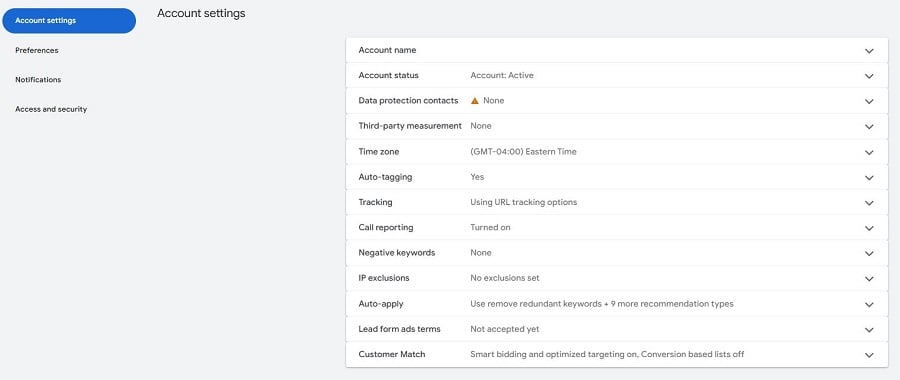
Account-level tips
As you poke around the account level, here are three general Google Ads tips to keep in mind:
- Decide how you want your account to be structured: This question arises constantly: What is the perfect account structure? I hate to break it to ya, but there is, truthfully, no magic recipe for structuring your account, and more than one strategy can prove successful. Luckily, there are a few different methods that work well:
-
-
- Based on the structure of your website: How is your website structured? Do you have different tabs or pages for different products or offerings? Do you value different product pages over others? If your website is well-structured (which it should be), then it makes sense to structure your Google Ads account in a similar fashion.
- By products/services offered: This is likely the same as the structure of your website, but think about your different services or products offered and structure your account in a similar fashion. For example, let’s say you sell tennis gear; you would want to create a campaign for tennis rackets, tennis balls, tennis clothing, etc. Then, under the tennis rackets campaign, you might create separate ad groups for the brands you sell or perhaps for the size or gender the racket is for. Take a look at your various offerings and decide which ones are most valuable. Is there a very large demand for tennis bags online? Then you might want to run a campaign for tennis bags with a higher budget. Spend some time mapping out your products and deciding how you want to divvy up your budget between campaigns.
- Based on locations: Is location important to your business? Maybe you’re a law office that has multiple locations across New England, or perhaps you sell development courses in major cities ranging from London to Tokyo. If location targeting is important, then structure it based on this. For example, create a London campaign to sell your development course to only those in a particular radius of the city.
-
Of course, there are many other tactics to structuring your account, but it’s all about taking the time to come up with a rational structure that will be easy to manage, track, and optimize to get the best results over time. So take the time to ponder various structuring techniques, and decide on the one that works best for your business. Once you’ve decided, I’d recommend actually mapping out the structure on a piece of paper or in an Excel doc to get a full visual of the campaigns and ad groups you’ll be creating. Now, onto a couple more Google Ads account structure tips:
- Perform regular audits: Like with anything in small business marketing, you need to check in on your Google Ads performance regularly. When you audit your Google Ads account on a scheduled basis, you’re able to find areas for optimization before they turn into headaches.
- Be wary of auto-apply recommendations: Advice from Google Ads is like advice from a stranger—take it with a grain of salt. Google’s auto-applied ads and other optimization recommendations can be helpful at times where you’re short of ideas, but at the end of the day, you will know what’s best for your account.
The campaign level
In general, a marketing campaign can mean anything, but in Google Ads, the term “campaign” is the bucket that houses your ad groups. You’ll set your budget, targeting, the type of ad you want to run, and more at the campaign level. As mentioned above, you can only have one ad type per campaign, but you’ll have multiple ad groups per campaign and multiple campaigns per account.
What are the different campaign types in Google Ads?
Here are the seven different campaign types in Google Ads to be aware of:
- Search: Text ads that appear on Google Search.
- Display: Image ads that appear on websites in the Google Display Network.
- Shopping: Product ads on Google Search and the Shopping tab.
- Video: Animated ads on YouTube and the Display Network.
- Demand Gen: Immersive ads that appear on multiple Google networks.
- App: Ads for your app across multiple Google networks.
- Performance Max: Ads created from various assets shown across all of Google’s eligible networks.

Another note: For this post, our anatomy will follow that of an advertiser using Search, Display, and/or Video campaigns. Some components may vary by campaign type, which will be noted throughout. For help with Google Shopping campaign structure, check out post on the Google Shopping priority bidding structure.
Which campaign type should I use?
It’s a best practice to run a few different campaign types within your Google Ads account to maximize your performance across Google’s advertising networks. Different campaign types can help you hit different PPC metrics, so it’s in your best interest to try at least one or two when starting out.
For example, you may want to run a search campaign to catch folks while they’re searching on Google, as well as a display campaign for when they’re browsing other sites across the web. Some campaigns are industry-specific and may not be needed, like Shopping (for ecommerce businesses) or App campaigns.
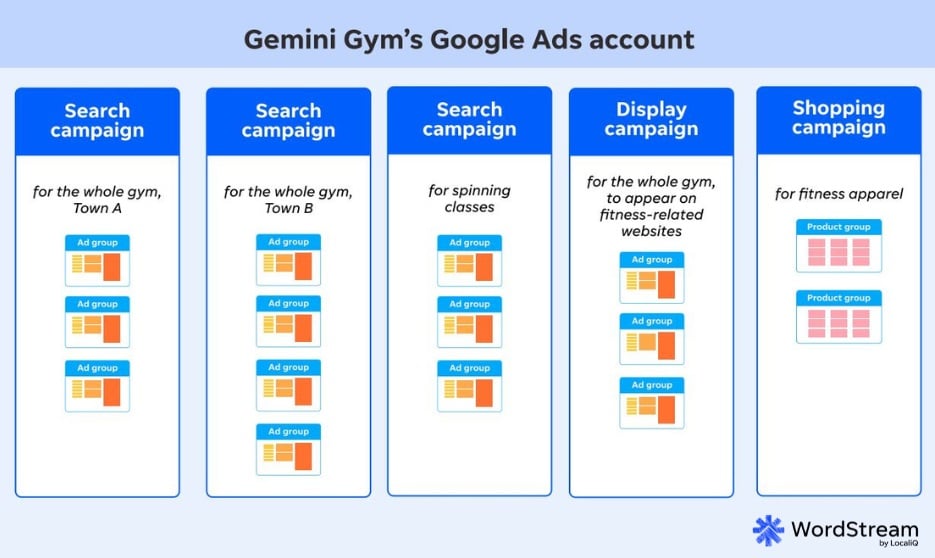
How many campaigns should I have?
This will all depend on your business size, business model, budget, and more. There’s no right or wrong answer when it comes to what campaign types you should have or how many of them, but it’s a best practice to keep it as manageable as possible.
So, for example, if you’re a small business running Google Ads and don’t have the overall budget or bandwidth to realistically stretch across 10 or 20 campaigns, it’s better to start small with one or two for effective advertising rather than be overwhelmed.
Keep in mind that you might not always have all your campaigns running at once. You might have seasonal offers, for example, or campaigns that you only run when you have the inventory or budget.
What’s the best Google Ads campaign structure?
This is all going to depend on your business size, type, model, and more. There isn’t a one-size-fits-all formula, but there are some options to consider. Similar to how you’d approach your overall account structure, take a look at how you group your offerings on your website to inspire your campaign makeup. What do you have unique pages for? Which pages are most popular or of the highest value? If your website is well-structured, you might want to adopt the same system for your campaigns. For multi-location businesses, it might make sense to run campaigns by location since location targeting is set at the campaign level.
Campaign-level settings
There’s a lot to play around with at the campaign level, like:
- Campaign name: Similar to account name, this is how you’ll refer to your campaign and has no impact on performance.
- Status: Paused, enabled, or removed.
- Conversion goal: What you want your campaign to achieve in relation to your conversion actions.
- Budget: Roughly how much your campaign will spend per day.
- Bid strategy: How aggressively you want to bid, based on your goals. See our complete guide to bidding strategies.
- Locations: Where in the world you choose for your campaign’s ads to show, also known as geotargeting.
- Languages: This is not the language of your ad, but what languages you want your ad to show for.
- Networks: In some campaign types, like Google Search, you can opt to show your campaign solely on the Google SERP or also on Google’s subsidiary search engines within its Search Partner Network.
- Start and end dates: If you don’t want to worry about enabling or pausing your campaign, start and end dates can sometimes come in handy.
- IP exclusions: Any specific IP addresses you’d rather not show to.
- AI Max for Search campaigns: For Search campaigns, advertisers have the option to opt into AI automation for asset optimization and more.
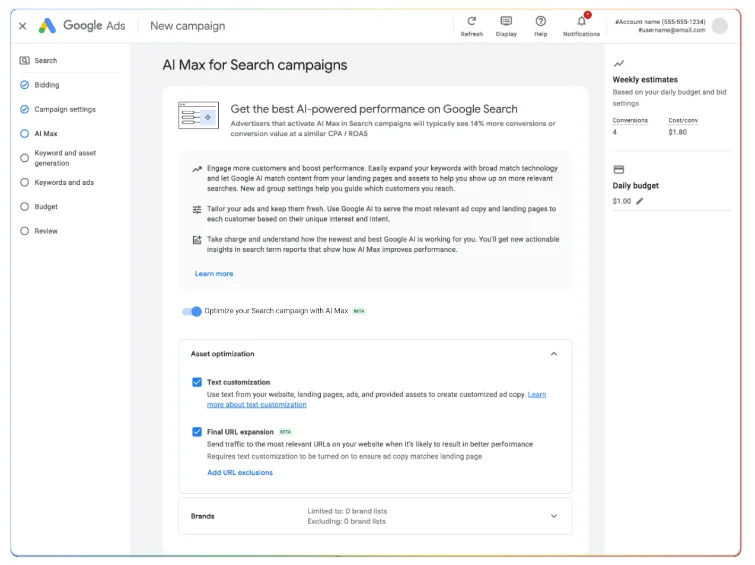
Campaign-level tips
When it comes to running Google Ads, there are a few campaign tips to keep in mind:
- Run a variety of campaign types. This will help you hit different business goals. Plus, they often work synergistically. For example, display campaigns can build brand awareness and improve your search ad performance. Of course, some campaign types are industry-specific and may not apply to your business.
- Keep them organized. Break out your campaigns so they map to your business goals, such as by product or service type, conversion action type, sales funnel stages, or locations. And establish a naming convention that makes sense to anyone managing the account.
- Separate out branded campaigns. These campaigns behave and perform differently from non-branded campaigns, so it’ll be best to budget for, strategize, and report on these separately.
💡 Is your Google Ads account structure in need of a refresh? Find out, and get an instant account report, using our Free Google Ads Grader!
The ad group level
Going down one tier under campaigns, we have ad groups. Each ad group contains a group of related keywords, their associated ads, and a landing page. One sidenote, though, for PMax campaigns, these are known as asset groups.
I only want to create one ad–why do I need an ad group?
You’ll notice when creating an ad that you’re prompted to create an ad group. This is a required part of the process, even if you just want one ad. But as we’ll talk about later, it’s best to have at least two different versions of your ad so you can test and see what performs best.
In most cases, you won’t have just one ad in your Google Ads account.
Here’s an example to explain why: Let’s say you’re a home service business and you want to advertise two main offers: installations and repairs. Installations are of higher value to you than repairs, so you separate these into two different campaigns.
That way, you can allocate more budget toward installations (because, as we just learned, budget is set at the campaign level, not the ad level). But you have different types of installations, like windows, gutters, and more.
You want to keep the same location, network, and device targeting for each of these offers—so it works to keep them in the same campaign—but the targeted keywords and ad copy for your window installation ad will, of course, be totally different from your gutter installation ad.
The same goes for your different types of repairs. So, you’ll want to have a separate ad group for each type of installation. Not only will this keep your account organized, but it will also keep your costs low.
How do thematic ad groups lower my ad costs?
The higher your Quality Score, the lower your cost per click, and you achieve high Quality Scores by keeping your ads and landing pages super relevant to their keywords. So, if you put all of your installation ads in one ad group, you’ll have window installation ads connected to gutter installation keywords—not very relevant.
Plus, you can only have one landing page per ad group, so you’d need to make it general enough to cover everything—once again, not very relevant.
If you separate your ad groups out, you can ensure tight alignment between your keywords, ad, and landing page for a better play in the Google Ads auction.
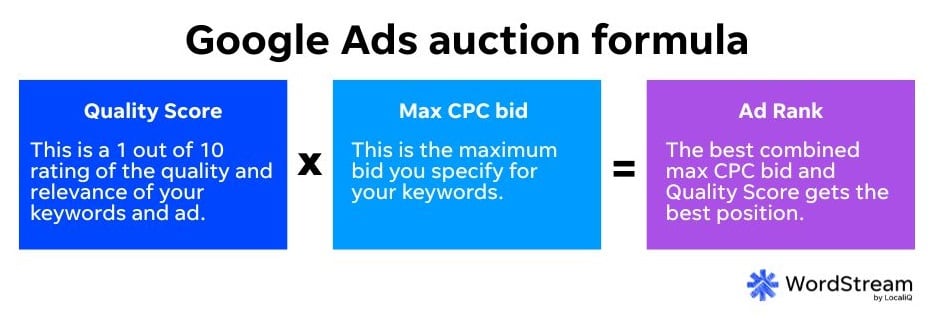
How many ad groups should I have per campaign?
You should have no more than roughly 7-10 ad groups per campaign. You’ll most likely need even less than that. The more centralized to your main goals or offerings, the better. If you have a ton of ad groups, that’s a sign you need another campaign!
How many keywords should I have per ad group?
You should have only one keyword theme per ad group (as we established), so you may only need to start with 10-20 keywords max. With all the keyword matching updates, we don’t need as many as we once did, so stick to your core terms and avoid muddying up the waters with a ton of variations.
How many ads should I have per ad group?
You should aim to have two or three ads per ad group. This is a little confusing since responsive search ads themselves rotate through different copy combinations within the same ad, but you should still always be testing more than one overall approach or tone at a time, such as an RSA with a set of positively-framed headlines and descriptions vs one with those that are negatively framed.
Note that you can only have three enabled RSAs per ad group, or otherwise you’ll get a flag that looks like this when you try to create another ad:
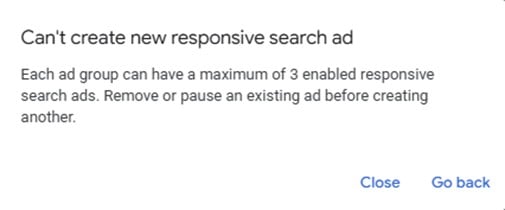
Ad group-level settings
Here is a quick preview of what you can adjust at the ad group level:
- Ad group name: Same as campaign and account levels, name your ad groups what would make the most sense to you. Again, the names of your assets are not a performance factor.
- Ad group status: Whether your ad group is paused, enabled, or removed.
- Ad group settings for AI Max: How you choose to leverage AI to optimize your brand lists, keywords, location targets, and more.
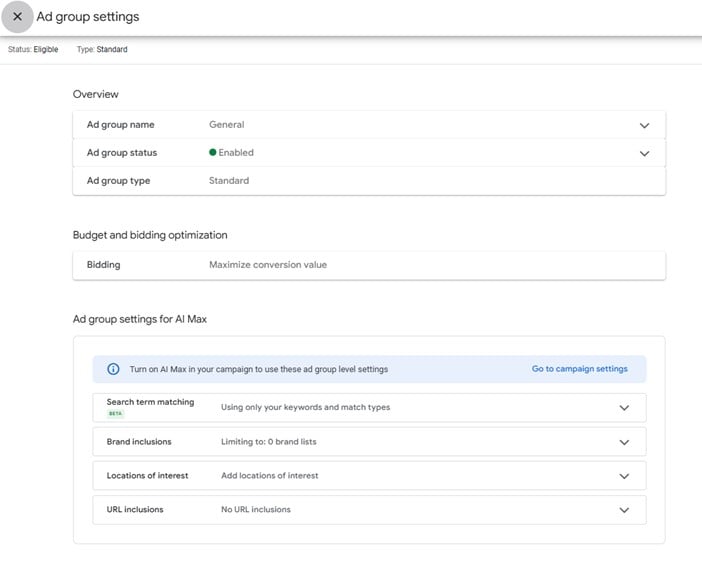
Ad group-level tips
Recommended best practices for ad groups are as follows:
-
-
- Do organize your ad groups systematically. Stick to core ad group themes and break them out in a way that makes the most sense for you. Themed ad groups will help to keep your ad relevance high, which is essential if you want to compete in Google Ads without having to hike up your bids.
- Don’t use too many or too few ad groups. While you don’t want to stuff everything into one ad group, you also don’t want to break them out too much into a SKAG (single keyword ad group) structure as either option can equally be a pain to manage.
- Do get ready to change these regularly. As a PPC expert, pausing, adjusting, and moving around ad groups and their components is the bulk of my optimization work.
- Don’t add in ad group components just to hit our recommended numbers above. Those are guidelines, so don’t break your back squeezing in an unnecessary keyword or ad group to hit an ideal number.
-
The keyword level
Keywords act as your “north star” within your Google Ads account. For Search, they indicate to Google which types of queries you want your ads to show for.
Note: PMax campaigns use search themes instead of keywords.
What are Google Ads keyword match types?
When you select or edit your keywords, you’ll also have to assign them a match type. There are three match types to choose from:
- Broad match: Least restrictive; matches your ad to any queries related to that keyword.
- Phrase match: Matches your ad to any queries that include your keyword or include anything that means the same thing as the keyword.
- Exact match: Most restrictive; matches your ad to queries that are your keyword or are of the same meaning as the keyword.
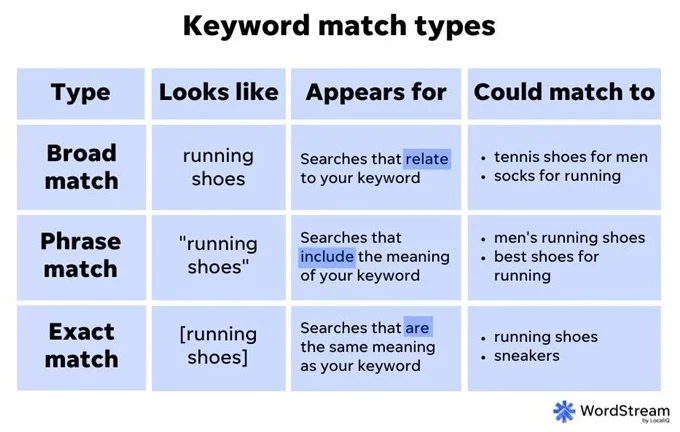
Keyword-level settings
As you add keywords, these are the settings you will apply:
- Keyword bid: Only necessary if you’re using manual bidding.
- Match type: This will depend on your strategy.
Keyword-level tips
Check out these quick Google Ads keyword tips:
- Do your PPC keyword research. This is non-negotiable! Use keyword research tools to identify the most relevant keywords for your offerings and make sure you’re capturing transactional or commercial intent.
- Mix up your match types. This will give you flexibility to see which match type works best for your core terms.
- Maintain your keyword lists. Adding your keywords to your ad group is just the first step in the process. You need to be regularly mining your search terms report to find new keywords to add, negative keywords to negate, and low-performing keywords to remove, pause, or separate out.
- Don’t just go for the lowest CPC keywords. Some keywords are going to have a higher average cost per click than others, but these will typically bring in higher value clicks and conversions.
- Don’t ignore other targeting options in favor of keywords. These may be the building blocks of Google Ads, but you still need to pay attention to your location, device, and audience targeting.
The ad level
We’re now down to the most granular part of your Google Ads account anatomy: the ad level. This is where we get to the good stuff: your ads! These, of course, are what your targeted users see. Who knew that for the one ad you see on a website or SERP, there are so many doors to open to get there?! When building out a campaign, the ad level is where you input text and upload or generate creative assets.
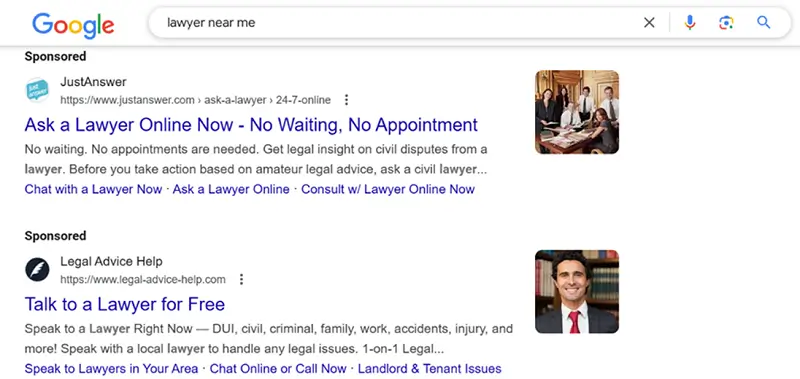
An example of what ads look like on the SERP.
If you’re creating a search ad, it’s important to stick to responsive search ad copy best practices, like pinning headlines and descriptions sparingly, and using keywords carefully, rather than excessively.
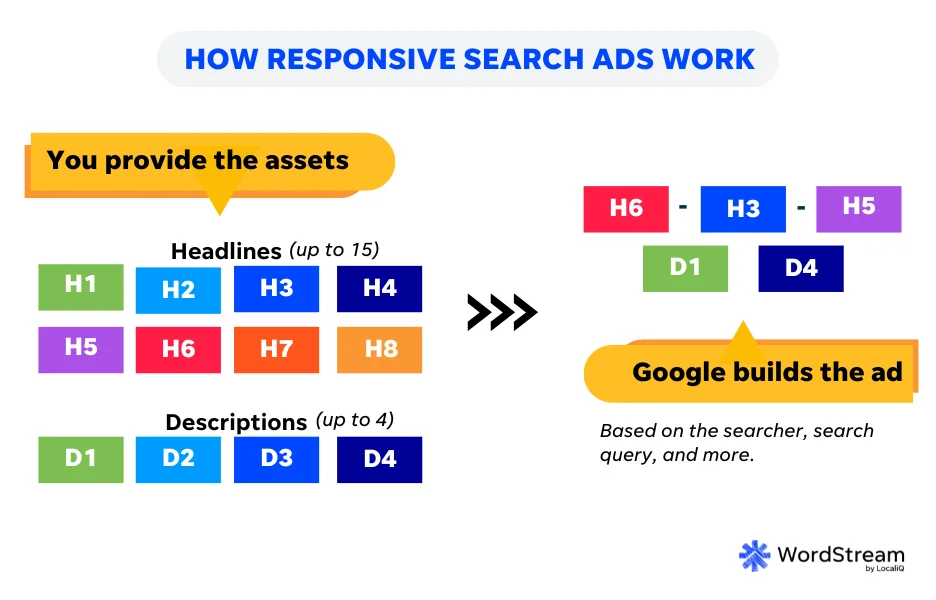
Ad-level settings
There are a couple of components you can change within the ad creation portal:
- Ad components: Assets like your headlines, descriptions, videos, or images.
- Landing page URL: Where you’ll be pointing your ad to. All ads within the same ad group have to point to the same landing page URL. All ads within a campaign have to point to the same domain.
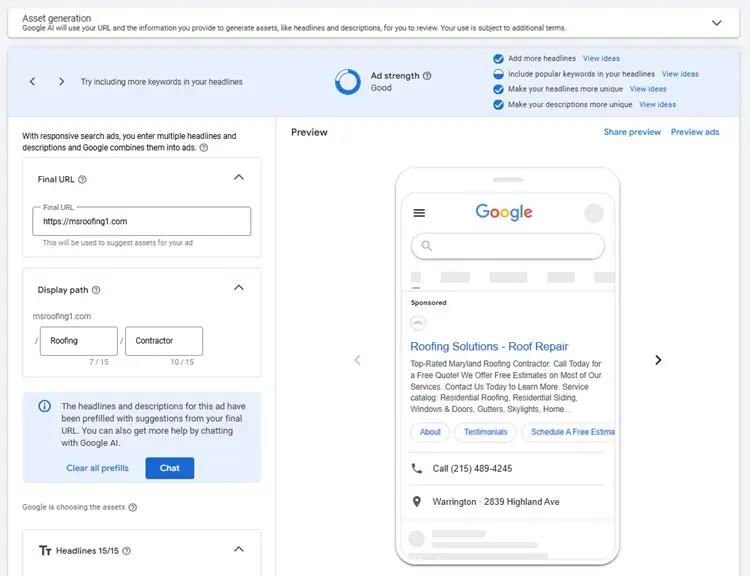
Ad-level tips
Remember the following when creating your Google Ads:
- Be strategic with your ad copy. A great ad includes the right mix of features, benefits, differentiators, and CTAs. Use these tips for writing exceptional ads.
- Always be testing. Until mind-reading becomes widely available, this is the only way you’ll know what type of ad best appeals to your customers. Try swapping different keywords to go along with your ads, different images on Display ads, video lengths on Video ads, or include different language that speaks to a specific product price or service offering.
Google Ads account anatomy: unpacked
Paying attention to each aspect of your Google Ads account can pay off in the long run, as you’ll have a fully customized strategy. Whether you’re just starting out in PPC or a seasoned pro, these Google Ad account components are worth working on. Looking for tips to future-proof your PPC account structure? We’ve got you covered!
Remember, a proper account structure will allow you to build out a full-funnel strategy customized to your unique goals and scale as you see more success. For maximized account performance, see how our solutions can help you create the perfect Google Ads account structure for your business.







